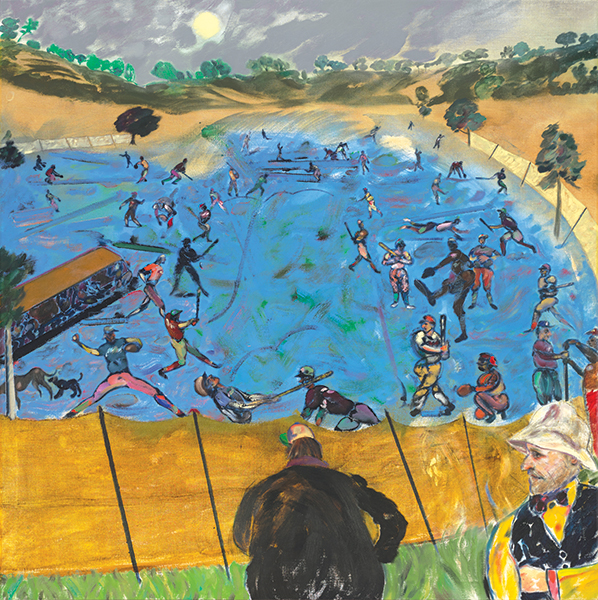A Closer Look at R.B. Kitaj’s Amerika (Baseball)

London figurative artist R.B. Kitaj (1932–2007) was a second-generation Russian-Jewish immigrant who grew up in Cleveland, Ohio, yet lived in England for almost 40 years as an expatriate. Amerika (Baseball) was painted in England and references Kitaj’s personal history of displacement and uses baseball—the iconic American game—to represent the diasporic experience and the resulting nostalgia. Beneath the Shaker Basket Blue of the field and dynamic movement of the baseball players hides a symbolic representation of estrangement and national belonging.
Kitaj was passionate about baseball. For him it stirred memories from his childhood and symbolized his deep connection to America. In Amerika, each player is absorbed in his own actions, creating a showcase of the different positions and mirroring human behavior at the same time. The oval arena with the tiny figures takes on the aspect of a theater stage.
The pitcher is Satchel Paige—the greatest Negro League pitcher ever and, at the age of 42, the third player to break the color barrier and join a major league team in 1948. He helped Kitaj’s hometown Cleveland Indians win the World Championship. In Amerika, Paige symbolizes the bittersweet legacy of African American integration.
Art historic and literary references are constant in Kitaj’s work. Franz Kafka’s unfinished novel Amerika: The Man Who Disappeared (1927)—the story of a young European immigrant, Karl Rossmann, in the United States—inspired the title of the painting. The blue field suggests the ocean that the protagonist of Kafka’s novel had to cross to get to America as well as Kitaj’s experience as a merchant seaman when he was a young adult, sailing throughout the Caribbean and South America. It also evokes the mass immigration of European Jews, especially in the 20th century, crossing the sea to escape from pogroms and the Holocaust.
Kitaj had a vast visual repertoire with Paul Cézanne and Edgar Degas being his main inspirations. Diego Velázquez’s painting Philip IV Hunting Wild Boar (La Tela Real), which Kitaj saw at the National Gallery in London, inspired this composition. The hills and trees around the enclosure in the 17th-century canvas reminded the artist of the low hills surrounding the playing fields in his native Ohio and upstate New York, where as a child he watched baseball games. The “centrifugal composition,” the “flat expanses of color” and energetic motion of the bodies recall Henri Matisse’s Danse (I). And the somewhat distorted figures evoke Francis Bacon who Kitaj knew when living in London, and with whom he shared a primary focus on the human figure.
The figure in the lower right corner is the artist himself—recognizable by his characteristic profile and blond beard. Kitaj often depicted himself and loved ones, especially his second wife, in his paintings. In Amerika he places himself as an outsider, turning his back on the field, while observing the players in the arena.
Kitaj was an accomplished draftsman and developed a particular technique of applying thin glazes of paint with a dry brush, a technique that he called “drawing-painting.” Amerika (Baseball) is part of Yale University Art Gallery’s permanent collection and is on exhibit now in Artists in Exile: Expressions of Loss and Hope.
Artists in Exile: Expressions of Loss and Hope
On view through December 31, 2017
Yale University Art Gallery, New Haven, CT
artgallery.yale.edu
Frauke V. Josenhans is the Horace W. Goldsmith Assistant Curator of Modern and Contemporary Art at Yale University Art Gallery. Sarah Baker is editor in chief of Art New England.
Image: B. Kitaj, Amerika (Baseball), 1983–84, oil on canvas. 58 x 58″. Yale University Art Gallery, Charles B. Benenson, B.A. 1933, Collection. © R. B. Kitaj Estate, Courtesy Marlborough Fine Art. Photo: Yale University Art Gallery.
